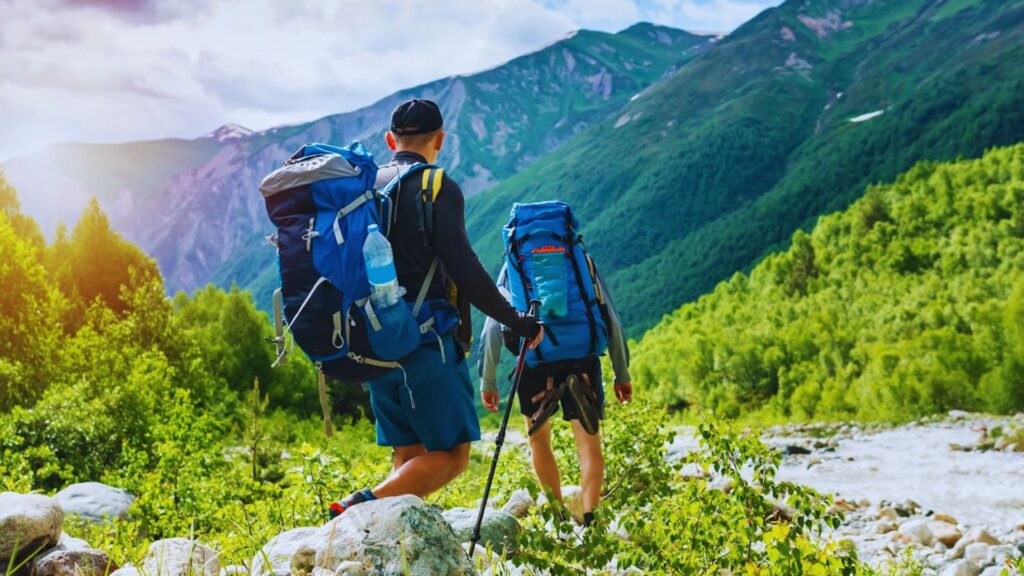Trekking is an exhilarating way to explore nature, challenge yourself, and reconnect with the outdoors. However, the unpredictable nature of wilderness environments demands careful preparation. Whether you’re planning a day hike or a multi-day expedition, the right gear is essential to ensure safety, comfort, and an enjoyable experience. In this blog, we’ll discuss the ten essentials that every trekker should carry, regardless of the trek’s difficulty or duration.
1. Navigation Tools: Map, Compass, or GPS
When you’re out on the trail, your sense of direction can easily become disoriented, especially in dense forests, rugged terrains, or when weather conditions turn. Even if you’re following a well-marked path, carrying proper navigation tools can prevent you from getting lost.
A topographic map and a compass are lightweight and don’t rely on batteries, making them reliable companions. For modern trekkers, a GPS device or smartphone with offline maps adds convenience but should never replace a physical map. Be sure to familiarize yourself with these tools before setting out. Remember, technology can fail, so always have a backup.
2. Adequate Clothing Layers
Weather conditions can shift dramatically in the wilderness, especially at higher altitudes or during longer treks. To stay comfortable and safe, it’s essential to layer your clothing properly. Follow the three-layer system:
- Base Layer: Moisture-wicking materials like merino wool or synthetic fabrics help keep sweat off your skin.
- Insulating Layer: A fleece or puffy jacket traps body heat, keeping you warm during chilly conditions.
- Outer Shell: A waterproof, windproof jacket protects you from rain, snow, and wind.
Don’t forget a hat and gloves for colder climates, and in warmer conditions, pack a sun hat and sunglasses.

3. First Aid Kit
Injuries can happen when you’re trekking, from blisters and scrapes to more serious issues like sprains or insect bites. A well-stocked first aid kit is crucial for dealing with minor medical problems until you can seek professional help.
At a minimum, your kit should include adhesive bandages, gauze, antiseptic wipes, tweezers, pain relievers, blister treatment, and any necessary personal medications. Consider adding a small guidebook on wilderness first aid if you’re venturing into remote areas.
4. Hydration System
Proper hydration is key to staying energized and healthy on the trail. Dehydration can lead to fatigue, headaches, and even more severe conditions like heat stroke or hypothermia. Carry at least 2 to 3 liters of water, and make sure to have a reliable method of purifying water if you’re trekking for more than a day.
Water purification tablets, a portable water filter, or UV purifiers are lightweight and effective options. Hydration packs with built-in reservoirs allow for hands-free drinking, making them popular among trekkers.
5. Food and Nutrition
Trekking burns a lot of energy, so you’ll need enough calories to keep your body fueled throughout your hike. Pack high-energy, non-perishable food that’s easy to prepare and eat on the go. Examples include:
- Energy bars, nuts, and trail mix
- Dehydrated meals for longer trips
- Jerky or dried fruit for added nutrients
- Instant soups or noodles
Even if you plan a short hike, always carry extra food in case your trek takes longer than expected due to unforeseen circumstances.
6. Fire-starting Tools
Fire can be a lifesaver in emergency situations, especially if you’re caught in cold weather or need to signal for help. Always carry at least two methods of starting a fire—waterproof matches, a lighter, or a fire starter kit with dry tinder.
Even if you’re trekking in a warm climate, the nights can get cold, or you may need to cook food. Practice starting a fire before your trek, so you’re confident you can do it in less-than-ideal conditions.
7. Shelter and Sleeping Gear
In case of an emergency, having shelter can protect you from the elements and significantly increase your chances of survival. A lightweight emergency bivvy sack, space blanket, or tarp is essential, even on day hikes. For multi-day treks, your tent should be easy to set up, durable, and weather-resistant.
Your sleeping system should include an insulated sleeping bag appropriate for the climate and a sleeping pad for added comfort and insulation from the cold ground.
8. Illumination: Headlamp or Flashlight
Navigating in the dark without proper lighting can be dangerous. A headlamp or flashlight is a must-have, even if you’re not planning to hike at night. Accidents, delays, or even sunset approaching faster than expected can leave you in the dark unexpectedly.
Opt for a headlamp as it allows for hands-free operation, which is useful when trekking or setting up camp. Ensure you pack extra batteries or a backup light source, and choose a device that has a red-light mode to preserve night vision.

9. Multi-tool or Knife
A good multi-tool or a sturdy knife is indispensable on the trail. Whether you need to cut rope, open packages, fix gear, or prepare food, a multi-tool can come in handy for various tasks. The versatility of a multi-tool can save you from carrying additional gear, and some models even include scissors, screwdrivers, and can openers.
In more extreme scenarios, a knife could help with emergency situations like cutting bandages, gathering kindling for fire, or creating shelter.
10. Sun Protection
Exposure to the sun at high altitudes or during long hikes can lead to sunburns, dehydration, and heat exhaustion. Sun protection is essential to prevent these conditions. Along with your wide-brimmed hat and UV-protection sunglasses, always apply and carry sunscreen with a minimum SPF of 30, and don’t forget lip balm with SPF.
Reapply sunscreen throughout the day, especially if you’re sweating or at high altitudes where the sun’s rays are more intense.
Conclusion
Trekking can be an incredibly rewarding experience, allowing you to immerse yourself in the beauty of nature while pushing your limits. However, nature can also be unpredictable, and preparation is key to ensuring your safety and comfort. These ten essentials cover the most critical aspects of any trek, from staying hydrated and nourished to protecting yourself from the elements.
Whether you’re a seasoned trekker or a beginner, always pack these items, tailor them to the specifics of your trek, and consider local conditions and regulations. Preparedness ensures that you can fully enjoy the adventure while minimizing risks.
















Leave a Reply